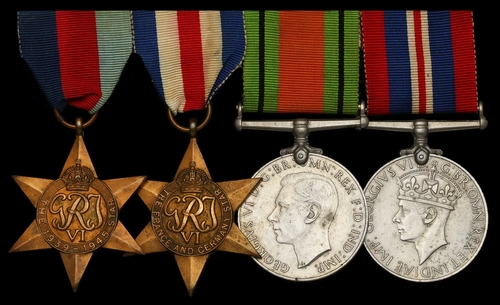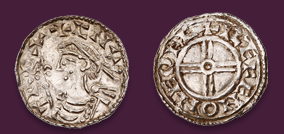
Auction: 25002 - Orders, Decorations and Medals
Lot: 50
Four: Flying Officer C. F. Merritt, No. 149 Squadron, Royal Air Force, who shared in 'Operation Manna' over Holland in May 1945
1939-45 Star; France and Germany Star; Defence and War Medals 1939-45, mounted as worn, sold together with his Flying Log book, very fine (4)
C. F. Merritt commenced his flying training at No.4 E.F.T.S Brough on Tiger Moths and had completed 11 hours and 40 minutes Dual and a total of 20 minutes as Pilot. His training was transferred to No.32 E.F.T.S Bowden in Alberta, Canada where he began training on Stearman aircraft on 29 September 1942 but also continued to fly the Tiger Moth in addition. Merritt transferred to No.38 S.F.T.S. based at Estevan, Alberta and commenced flying training on Anson II and he went solo on 21 December. He returned to the U.K. in July 1943 and was stationed at No.6 (P) A.F.U. flying Airspeed Oxfords.
He moved to 1525 B.A.T. Flight at Docking, Norfolk continuing on Oxfords. In early 1944 he commenced flying in Durban, South Africa, this time on Short Sunderlands and was involved with Transport Flights flying from Durban on 22 March 1944 up to Cairo and then returning back to Durban by the 8 April 1944. On his return back to the U.K. he joined No.12 O.T.U. and began flying Wellingtons as both Pilot and 2nd Pilot from 15 August 1944. He carried out a number of training missions between 18 September - 3 October banking a number of hours in both Day and Night training exercises. An entry for 6 October noted a 'Bullseye' Op however he was recalled after flying 2:35 hrs.
Merritt then joined 1669 Heavy Conversion Unit in December 1944 and started flying Lancasters, he performed a Diversionary Sweep on 14 February 1945 and then was posted to No.149 Squadron based at R.A.F. Methwold, Norfolk who were now equipped with Lancasters.
Flying as Pilot he had an Op to the benzol factory at Gelsenkirchen on 19 March 1945 dropping an 11,000lb bomb, his log book notes the flak was moderate but noted they were hit. This entry in the log book was perhaps an understatement as Flight Sergeant G. A. Dane (Air Bomber) was hit in the face from the flak and subsequently died as a result of this. Dane was buried at Hendon Park cemetery where his crew were all pall bearers. Dane's passing appears to have been the inspiration for some paranormal activity as stated in Methwold 149 Squadron by John Jonson:
'As part of their superstition, the crews had a great aversion to flying in a Lancaster in which a crew member had been killed. When this happened, the Lancaster damage was repaired in the maintenance hangar near the radar section, then the aircraft was transferred to another squadron, as just another anonymous replacement. We had two such aircraft that I can remember at Methwold.
One was Lancaster OJ-O, NF 976 which returned from a night raid on the railway marshalling yards at Hohenbudberg, with an injured rear gunner who died shortly afterwards. They had been attacked by a Messerschmitt Me 109 which the mid-upper gunner claimed that he had shot down. It was believed that the interrupter gear, known as 'taboo tracks' on the mid-upper turret which controls where and when the guns cannot fire, had failed. This resulted in the mid-upper gunner shooting into the rear fuselage of his own aircraft, putting bullets into the back of his own rear gunner. That aircraft sat around for a while pending full inspection and report, then it was repaired and shipped out.
The other was Lancaster OJ-J, NG224, following a G-H raid on the benzol plant at Gelsenkirchen. In this raid, there was heavy flak, and 11 of our aircraft were hit, the bomb aimer of J being killed, he being hit in the face by a piece of shrapnel. I was working on this particular flight line at the time, and went to service this aircraft which was at its dispersal point. As yet I hadn't heard of the tragedy. I saw the smashed bomb aimer's panel, and then I was asked by the sergeant on the flight line to hold my inspection for a while. The aircraft fitters were stripping out the green vinyl covered sponge pads on which the bomb aimer laid, which were soaked in blood, and whatever else that they could take out of the nose that was blood splattered, and these were buried in a pit alongside the dispersal. The aircraft then went off to the maintenance hangar, to be repaired and transferred. Forty years later, I returned to Methwold, and where the flight line lay was now a long thin hut which was where pig research was being carried out. The dispersal under question would have been somewhere near the end of the hut. By the long arm of coincidence, a lady working in the room at then of the research building swears she has seen an airman, not once, but two or three times, passing through the room. She was totally unaware of the existence of a flight line of Lancasters sitting in the same location as she now worked, or of the dead airman.'
Operation Manna
Merritt followed up this raid with an Op to Bocholt (north of Essen) on 22 March 1945. When Hitler had committed suicide on 30 April 1945 the end of the war in Europe was fast approaching given the situation in Germany and particularly Berlin.
No.149 Squadron began a new role as opposed to dropping bombs they were now tasked with dropping food supplies to the starving Dutch. This was to be known as 'Operation Manna', the designated aircraft were to fly along well defined corridors with no gunners on board, the promise being given by Germany that the aircraft wouldn't be attacked on these mercy missions. The food would be dropped from 500 feet, just as on a bombing run only clearly marked sites. No.149 Squadron was given this task. His log book has entries for this as 'Special Duties - The Hague' on 3, 5, and 7 May followed by a further 'Special Duties- Rotterdam' on 8 May. A total of 12 aircraft took part with the drop zone being just outside of Rotterdam. On 14 May his log book has an entry again for 'Special Duties' - 24 P.O.W.s, followed again on the 27 May with a similar role again 24 P.O.W.s.. (Operation Exodus).
Despite the end of the war in Europe he remained with No.149 Squadron still in an active capacity flying over France, Germany and Italy. He transferred to No.15 Squadron in June 1946 and completed his flying on 18 July 1946.
Sold together with the following original archive:
i)
Royal Canadian Air Force Pilot's Flying Log Book.
ii)
Photograph from the Op on Bocholt.
iii)
Slip showing his Second World War Medal entitlement stamped 23 September 1945.
iv)
A copy of the Aircraft Captain.
Subject to 20% VAT on Buyer’s Premium. For more information please view Terms and Conditions for Buyers.
Sold for
£280
Starting price
£220




